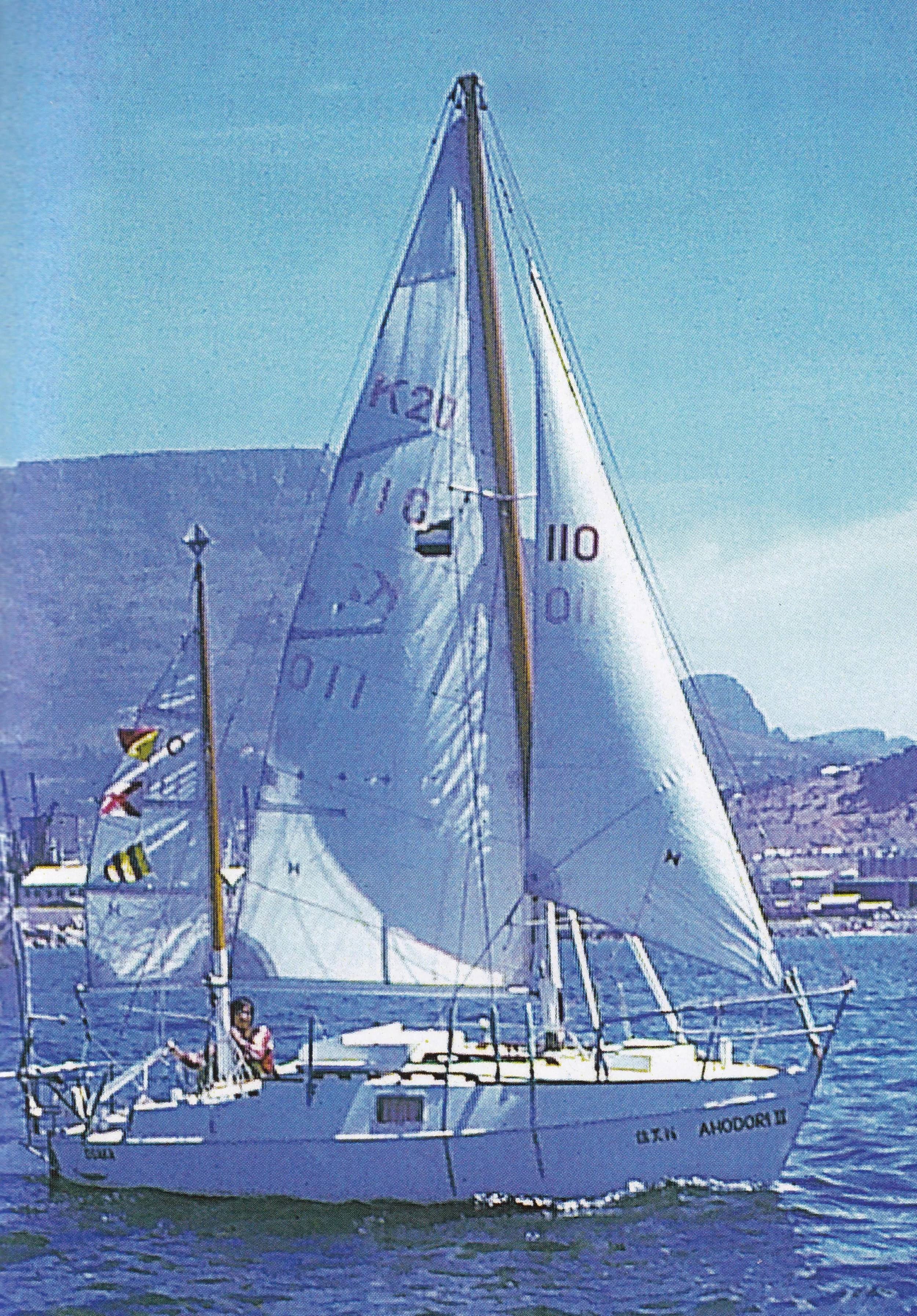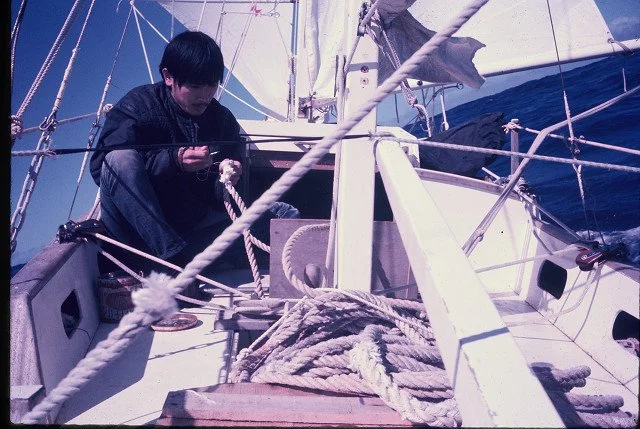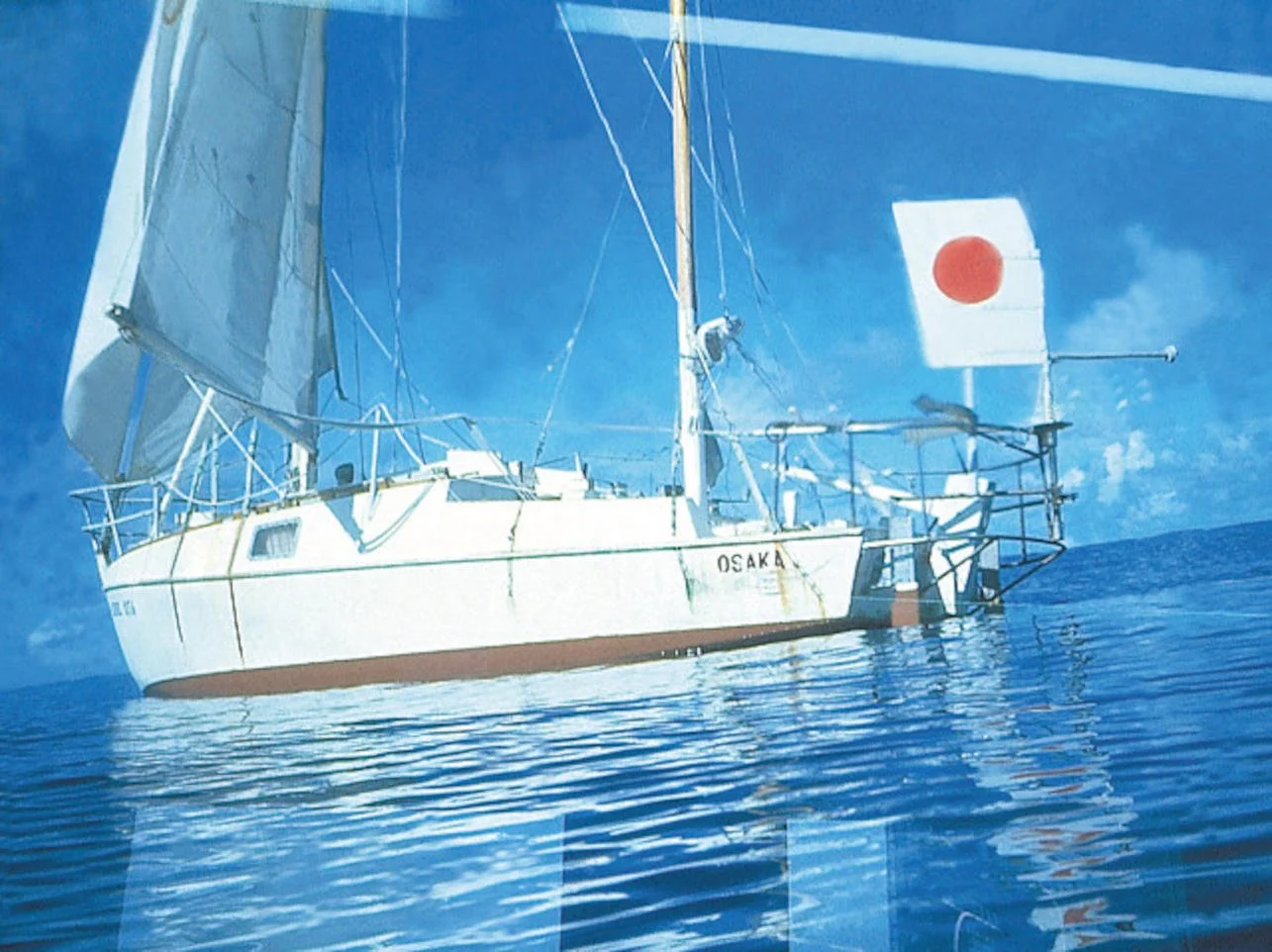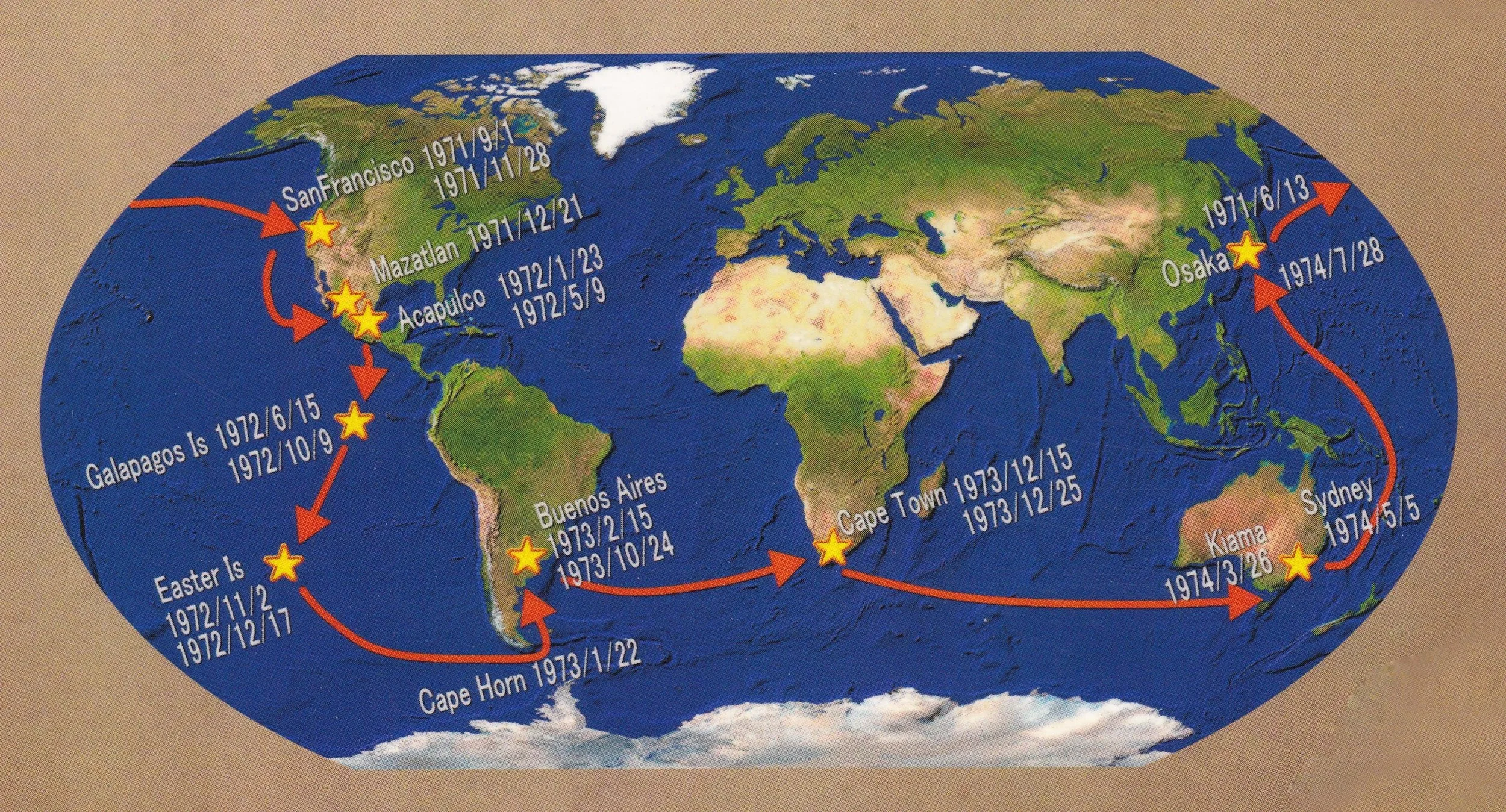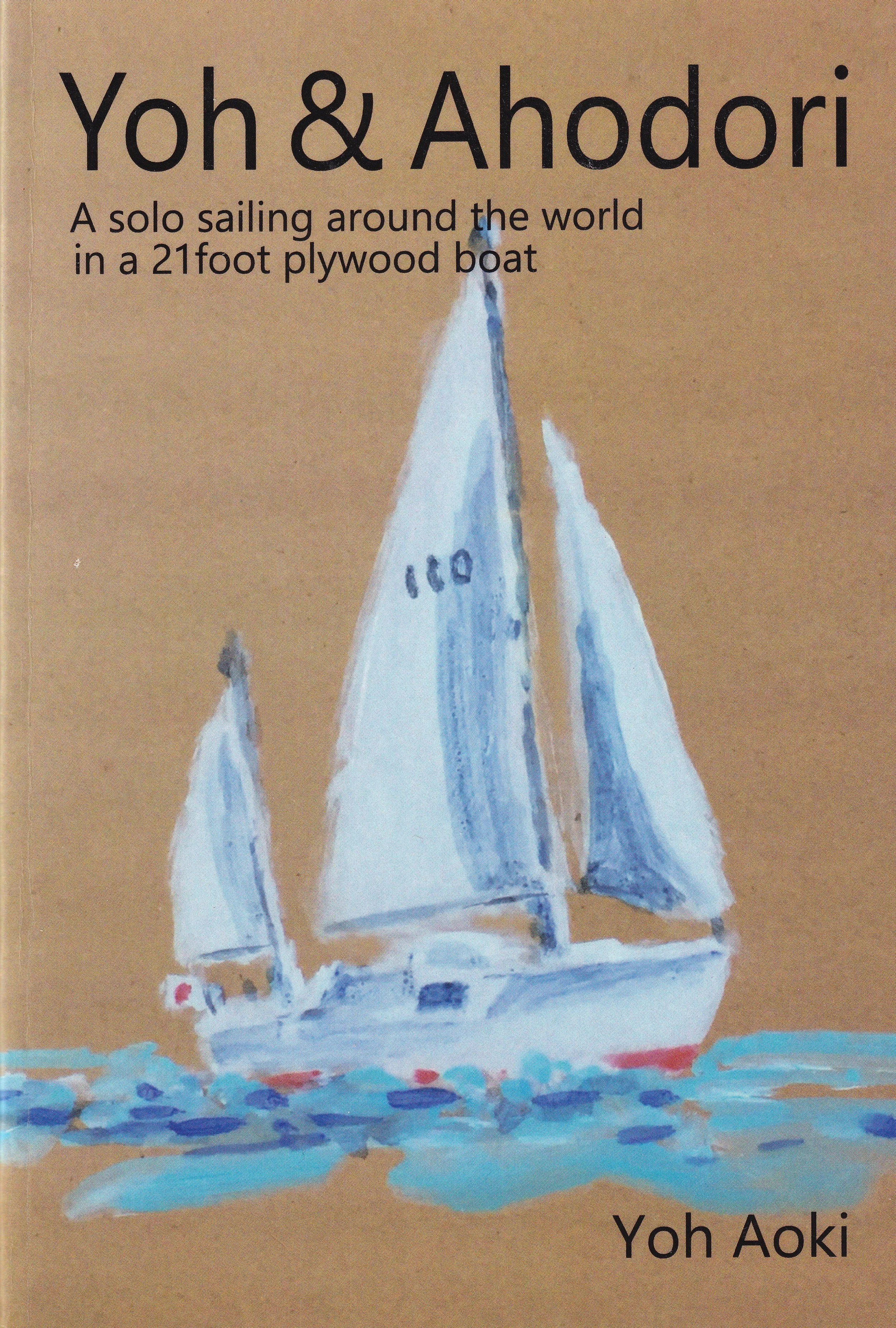Yoh & AHODORI
By Graham Cox
This is the story of a young Japanese sailor, Yoh Aoki, and his 21ft plywood ketch, AHODORI II, who completed what may possibly be the most audacious solo circumnavigation of all time. He is little known outside of Japan, but I came across him in Sydney Harbour in May, 1974, on the last stop of his voyage.
Yoh and AHODORI II leaving Osaka
Autumn, 1974, was a rough season in the Tasman Sea. In May, two yachts were lost off the coast of NSW, one with all hands, when an unforecast East Coast Low, the worst in recorded history, swept through the area. A month earlier, I had set sail from Sydney for Auckland, at the ripe old age of 22, in my 40-year-old, tired, leaky, 24ft carvel-planked, engineless ketch, POEME, only to be beaten back to Jervis Bay, 100 miles south of Sydney, after 12 days at sea, when another East Coast Low collided with an ex-tropical depression, stalling over the area for more than a week.
The local trawlermen in Jervis Bay shook their heads, and one said, ‘I met another nutter like you out there recently, a Japanese fellow in a boat smaller than yours.’ A few weeks later I came across Yoh Aoki and AHODORI II at the Cruising Yacht Club of Australia (CYCA) in Sydney. AHODORI II looked like a very seaworthy boat to my young eye, and Yoh was certainly no nutter. I felt that it was a perfectly reasonable undertaking.
In 2022, when Yoh sent me his book, Yoh and AHODORI, which had just been translated into English, I finally realised the enormity of his achievement. It is a delightful little book, written with raw, emotional honesty, that allows the reader into AHODORI’s cabin, and into Yoh’s mind.
Yoh was 22 years old when he set sail in his home-built plywood ketch in June 1971, after spending two years building it in Osaka, Japan, and 25 when he returned in July 1974. That is a considerable achievement, but it is the route of his circumnavigation that is truly remarkable.
From Osaka, he sailed non-stop to San Francisco across the North Pacific in 83 days, emulating his hero, Kenichi Horie, who had made this passage in 1961 on the 19ft MERMAID. AHODORI II needed some repairs, and it was two months before Yoh took off again, bound for Easter Island and (gulp) Cape Horn.
He only got as far as Mazatlan, in Mexico, initially, as the hull-deck joint opened up in rough seas, and he felt scared and lonely after his warm, friendly months in San Francisco, where he made many friends. He considered giving up, but could not face the sense of failure, so he repaired the boat in Acapulco, and continued SE into the Pacific, making landfall on Easter Island 25 days later. He adored Easter Island, saying he had finally found the community he had been looking for, but felt driven to continue.
From there, he sailed around Cape Horn to Buenos Aires in Argentina, taking 61 days to make the passage. Experiencing extremely rough weather in his approaches to Drake Passage, it became dangerous to go on deck. To his horror, the boat began to take on water, and he discovered that the keel was loose. He could wiggle the keel bolts by hand. Eventually, AHODORI II capsized. Amazingly, the keel was still attached to the boat, but the windvane and radar reflector were nowhere to be seen.
The poor boat was rebuilt again in Buenos Aires, this time very thoroughly, with the assistance and generosity of the local community, who fell in love with Yoh, and tried hard to convince him to stay. But on 24 October 1973, he sailed for Cape Town, arriving there 53 days later. AHODORI II capsized three times in one night en route, after the storm drogue snagged the rudder and parted its cable, but the boat was finally up to the task and suffered no structural damage, despite also hitting a whale.
AHODORI II off Cape Town.
From Cape Town, AHODORI II traversed the much-feared Indian Ocean, which most Southern Ocean sailors say is the roughest of them all. Just a month before his departure, the 1973-4 Whitbread Round the World Race had left Cape Town bound for Sydney.
AHODORI II running before large seas in the Southern Ocean.
Two sailors had been lost, and one yacht destroyed. Ironically, AHODORI II suffered no major dramas on this passage, though Yoh was sick, first with chronic back pain, and later with a severely infected throat. After threading his way through the island-strewn Bass Strait, often running on ded-reckoning in thick weather, he made landfall in Kiama after 92 days, going on to Sydney a few days later.
From Sydney, after a pleasant rest, and socialising with new-found friends, he sailed nonstop to Osaka in 58 days. By this time, these sorts of extraordinary passages seemed commonplace to Yoh. He did not really want to stop at the end of this passage, or return to civilisation.
Ahodori and Yoh homecoming welcome
He dreamed of building a slightly bigger, more robust boat, AHODORI III, and setting sail permanently for the remote places on the planet. He had come to identify strongly with French solo circumnavigator, Alain Gerbault, whose books he read during the voyage.
Gerbault did exactly that, after his solo circumnavigation on FIRECREST, returning to the South Pacific on a new, purpose-built yacht. Unfortunately for Gerbault, World War II intervened, and he died in Timor during that conflict. Yoh did not realise his dream either, being absorbed back into Japanese society, where he became a successful businessman, building unique yachts that reflect his experience at sea, and developing a marina. But he retained the values he gained during his voyage, and is deeply respected in Japan for his ethical and spiritual practices.
Above all, he remains one of the most daring, resilient and determined solo sailors of all time.
Email Yoh directly if you would like a copy. The cost is US$25 plus airmail P&P US$8
Graham Cox is the author of The Junk Rig Hall of Fame, and the two-volume memoir, Last Days of the Slocum Era.






